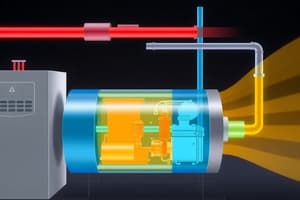Podcast
Questions and Answers
What is the primary function of the compressor in the refrigeration cycle?
What is the primary function of the compressor in the refrigeration cycle?
- To cool the refrigerant vapor
- To remove heat from the refrigerant
- To facilitate the expansion of the refrigerant
- To increase the pressure of the refrigerant (correct)
What occurs in the condenser phase of the refrigeration cycle?
What occurs in the condenser phase of the refrigeration cycle?
- Refrigerant vapor turns into gas due to heating
- High-pressure vapor refrigerant condenses into a liquid (correct)
- Liquid refrigerant absorbs heat from the environment
- Refrigerant liquid is expanded into a vapor
Which component allows the refrigerant to expand and change from liquid to vapor?
Which component allows the refrigerant to expand and change from liquid to vapor?
- Evaporator
- Condenser
- Expansion valve (correct)
- Compressor
In which part of the refrigeration cycle does the refrigerant absorb heat from the surroundings?
In which part of the refrigeration cycle does the refrigerant absorb heat from the surroundings?
What type of heat exchange is primarily conducted by the condenser in the refrigeration cycle?
What type of heat exchange is primarily conducted by the condenser in the refrigeration cycle?
What is the primary role of the evaporator in the basic refrigeration cycle?
What is the primary role of the evaporator in the basic refrigeration cycle?
Which of the following accurately describes the state of the refrigerant after it exits the condenser?
Which of the following accurately describes the state of the refrigerant after it exits the condenser?
What transformation does the refrigerant undergo when it passes through the expansion valve?
What transformation does the refrigerant undergo when it passes through the expansion valve?
How does the compressor influence the temperature of the refrigerant during circulation?
How does the compressor influence the temperature of the refrigerant during circulation?
In the context of the refrigeration cycle, what is the primary function of the condenser?
In the context of the refrigeration cycle, what is the primary function of the condenser?
Flashcards
Refrigeration Cycle
Refrigeration Cycle
A process for removing heat from a desired area by manipulating the pressure of a working refrigerant through compression and expansion.
Compressor
Compressor
Increases the pressure of the refrigerant, concentrating the heat it contains.
Condenser
Condenser
Removes heat from the high-pressure refrigerant vapor, turning it into a liquid.
Expansion Valve
Expansion Valve
Signup and view all the flashcards
Evaporator
Evaporator
Signup and view all the flashcards
Refrigeration Cycle
Refrigeration Cycle
Signup and view all the flashcards
Compressor
Compressor
Signup and view all the flashcards
Condenser
Condenser
Signup and view all the flashcards
Expansion Valve
Expansion Valve
Signup and view all the flashcards
Evaporator
Evaporator
Signup and view all the flashcards
Refrigerant
Refrigerant
Signup and view all the flashcards
Refrigeration cycle components order
Refrigeration cycle components order
Signup and view all the flashcards
Study Notes
Basic Refrigeration Cycle
- A refrigeration cycle, also known as a heat pump cycle, moves heat away from a desired area.
- This is achieved by manipulating the pressure of a refrigerant (like air, water or synthetic refrigerants).
- The cycle involves compression and expansion.
Major Components
- Compressor: Increases pressure of the refrigerant, concentrating the heat it contains. Changes low-pressure gas to high-pressure gas.
- Condenser: Removes heat from hot refrigerant vapor until it condenses into a saturated liquid. The refrigerant is then a high-pressure, low-temperature liquid.
- Expansion Valve: Reduces pressure from the liquid refrigerant, allowing it to expand and change state from liquid to vapor in the evaporator.
- Evaporator: Cools the refrigerant to absorb heat. A fan cools the system, converting refrigerant to a vaporous state.
Cycle Summary
- Compressor: Pressure increaser
- Condenser: Heat rejector
- Expansion valve: Pressure dropper
- Evaporator: Heat absorber
Studying That Suits You
Use AI to generate personalized quizzes and flashcards to suit your learning preferences.




